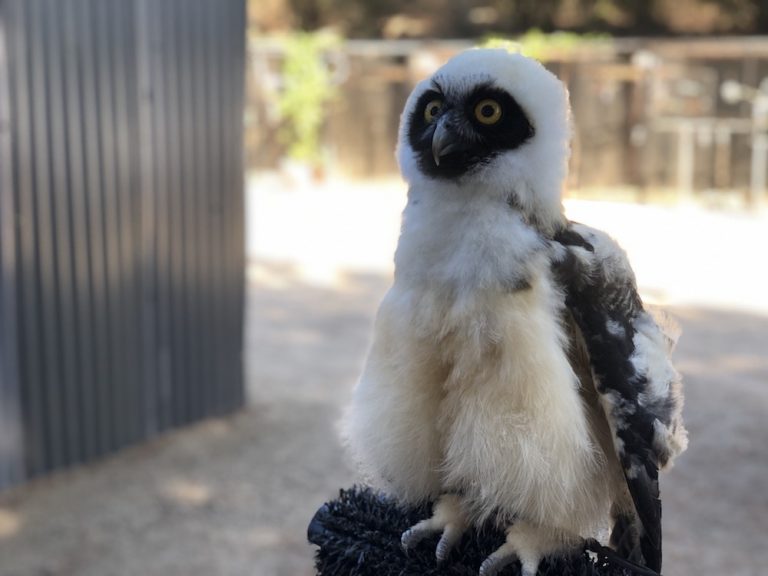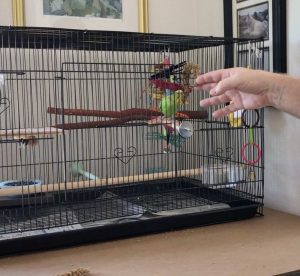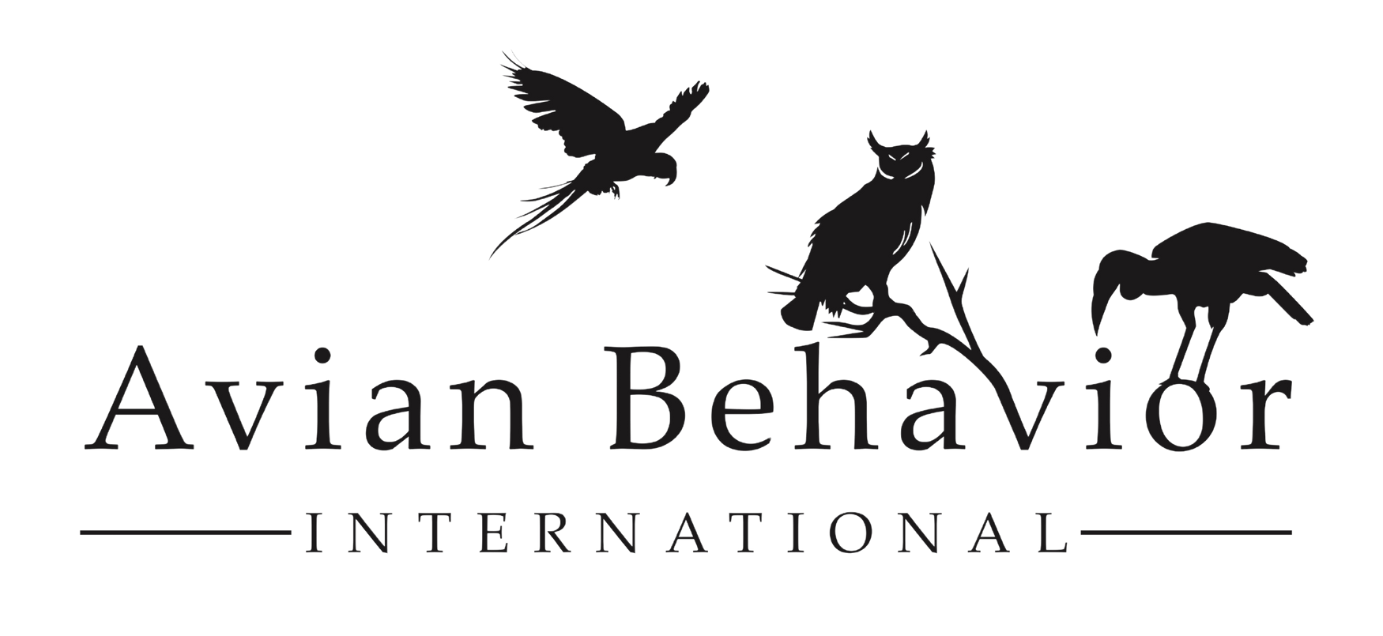
19 Aug What’s the Difference in Using Systematic Desensitization versus Counter Conditioning in Animal Training?
When we have an animal, or in our little avian saturated pocket of the world, a bird, that is showing fear, stress, aggression, or anxiety of some sort in response to a specific stimulus, traditionally we have turned toward procedures such as systematic desensitization or counter conditioning to change the bird’s emotional response. This can be especially needed when, say we have an owl that responds “in a certain way” to one of our fellow trainers on our team, a parrot that shows aggression towards hands or even a pen that we use for target training. Heck, I have trained many a budgie and parrotlet flock in living rooms with millet as my trusty counter conditioner.
Fearful and aggressive responses start as reflexive responses, which is why we think of them as emotional behaviors. We might think of the first time the bird was exposed to the stress inducing stimulus, for example, if there was something obvious. Perhaps the bird was grabbed and restrained, had hands come in and move bowls, perches, toys, and food around when the bird first arrived, or the trainer just presented differently than the bird was accustomed. Repeated exposures create conditions that shape the birds’ subsequent responses, which is where the reflexive, emotional response also takes on an operant component as well.
obvious. Perhaps the bird was grabbed and restrained, had hands come in and move bowls, perches, toys, and food around when the bird first arrived, or the trainer just presented differently than the bird was accustomed. Repeated exposures create conditions that shape the birds’ subsequent responses, which is where the reflexive, emotional response also takes on an operant component as well.
Systematic desensitization and counter conditioning are procedures that address the emotional responses. We want to change the way the bird feels about the stress-inducing stimulus. With that in mind, let’s take a closer look on what exactly these procedures entail.
Desensitization means to make an animal less sensitive. Systematic desensitization is a structured plan to get an animal habituated to a stimulus to a thing it doesn’t like in a way that fear is never triggered. With systematic desensitization, we expose the bird to a weaker version of the stimulus it does wants to avoid. There are many ways that we can weaken that stimulus: we can make it smaller, for instance if it is big or long. A scary person could be placed far away. A moving object, such as a rake or wheelbarrow could be made to stand still or moving very slowly. Loud noises, such as thunder or rain, could be replayed at quieter volumes. Depending on the stimulus, we can also combine any number of those qualities in order to create this procedure in a meaningful way, as students of our Masterclass on Raising an Owl Ambassador can attest!
However we can arrange the environment, whether we bring the bird closer to the stimulus or the stimulus closer to the bird, then we retreat the intensity before the bird’s threshold is reached. We take gradual steps, making the intensity of the stimulus stronger until the normal expression of the stimulus reached. At no point does the animal reach or breach the threshold of its stress response.
With systematic desensitization, there is no operant component. We are not marking any particular behavior, we are simply working within the bird’s calmness threshold. One of the scenarios we have found this particularly useful is where our bird isn’t too fearful of a particular stimulus, as in the conditions and emotional response isn’t too deeply ingrained. In our Masterclass on understanding behavior inside the Avian Behavior Lab, we have an example showing our use of desensitization with our owl while we are raking. Our spectacled owl isn’t too fearful, and the level of intensity is very easy to control. In this scenario, we are using a fresh slate, and she isn’t actively showing a high level of fear or arousal.
Counter conditioning means that we are re-teaching our bird to have a pleasant reaction to a stimulus it previously showed an aversive reaction to. We want it to associate something of value – something good – with the aversive stimulus to ideally change the bird’s reaction to a neutral or positive reaction. The problem stimulus can be a person, an object, such as a perch, a toy, a crate, or hands, another animal, a place, or an event.
There is not an operant component with counter conditioning, either, just as with systematic desensitization. We are just  pairing a reinforcer with the stimulus we want to change the reaction to. For instance, one trainer talked about an amazon’s extremely aggressive reaction of lunging and grabbing at the bars at him every time the trainer got near. In attempt to change this, he would drop sunflower seeds in the bird’s food dish every time he passed by in attempt at counter conditioning. This is one example of attempt, although with mixed long term results. With counter conditioning, however, the value of the reinforcer must at least match the level of intensity of the bird’s response.
pairing a reinforcer with the stimulus we want to change the reaction to. For instance, one trainer talked about an amazon’s extremely aggressive reaction of lunging and grabbing at the bars at him every time the trainer got near. In attempt to change this, he would drop sunflower seeds in the bird’s food dish every time he passed by in attempt at counter conditioning. This is one example of attempt, although with mixed long term results. With counter conditioning, however, the value of the reinforcer must at least match the level of intensity of the bird’s response.
Another example would be having a bird associate treats with a new room or a new home space that we want to accustom it to. Like systematic desensitization, we want to keep the bird from expressing a high state of arousal. Often, counter conditioning is paired with systematic desensitization in order to achieve this, using a weaker expression of the stimulus and pairing it heavily with reinforcers.
These two procedures have their place in our training toolkits. For us at Avian Behavior International, we see these procedures as helpful when we want to pair potentially scary or stressful situations when we are socializing our young ambassadors and prevent fearful or stressful responses from showing up. It is definitely a preventative measure! However, when we have a bird that is already showing a fear or stress response, including aggression, it means that an escape or avoidance contingency is already at play.
In these cases, attempting to layer a reinforcement contingency on top of an avoidance contingency will likely be less effective in our training paradigm and increase and prolong the amount of stress overall. It means that our animal is already showing us what it wants out of the situation, and we either aren’t paying attenrtion or we have superimposed our own values of prioritizing positive reinforcement or even pathological intervention on to the equation.
If our desire is to get the most out of our relationship with our bird and to enhance our own skills as trainers, understanding and progressing the use of negative reinforcement as a tool of both choice and control is so important here. It is already at play, as our bird is showing us that distance from the undesirable stimulus is what it wants.
The use of negative reinforcement as a choice-based procedure allows us to recognize that there are multiple contingencies happening in our interactions, whether or not we choose to recognize their presence.
There has been a lot about using Constructional Aggression Treatment, a procedure developed and published by Kellie Snider of North Texas University graduate program in 2007. This procedure starts with negative reinforcement and, once the bird has recognized that the trainer is responding to the specific behaviors they have offered by reinforcing with increased distance to the undesirable stimulus, the trainer can now switch to a positive reinforcement contingency, which was previously useless. We have shown in our work where negative reinforcement was used with incredible speed and success for our ornate hawk eagle to start eating in front of us while free lofted in her mews, untethered and not weight managed.
Negative reinforcement is exceptionally helpful when we don’t have a lot of other available reinforcers: the bird won’t take food reinforcers in the presence of the aversive stimulus, the response is extreme, such as the macaw that we worked with that showed fear for the pen we were using as a target. By embracing the understanding of the contingencies at play, we allowed the greenwing macaw we were working with to not only have control over the reinforcers at play, but also show him that we recognized what he valued most in his environment.
Using negative reinforcement in this way, we are fine tuning the conditions in the environment that are already there and allowing for the bird to operate. Desensitization and counter conditioning are not operant procedures. With negative reinforcement, we allow the animal to make a choice that will lead to the desired outcome: distance. Negative reinforcement is the only procedure mentioned here that is actively replacing the undesired operant behavior. The other two procedures are working solely with the emotional response.
So how do you know which procedure to do at what point? It really takes looking at the individual in front of you and the contingencies at play. If the strongest motivator is the escape/avoidance contingency, then negative reinforcement is likely going to be the fastest way to reduce stress, give your bird more skills, and get you both on your way to more reinforcers. If the avoidance response isn’t very high, as we mentioned with some of our socialization behaviors, then you can probably work with desensitization and counterconditioning quite comfortably.
Hungry for more information about negative reinforcement? I bet! There is actually a reason why there isn’t more talk about it out there! We began talking about it very carefully in our Advanced Training Workshops in 2018, and we got a little bit of pushback in some of our webinars in 2019. People were understandably afraid by all of the traditional science as well as folk intuition that has been out there about negative reinforcement. You can check out our course in the Avian Behavior Lab for our members on negative reinforcement.
You can try out an annual membership either Basic or Premium levels at only $3 for 10 days with the coupon code TEN
You can also get your pals together and get an annual Facility account for a ridiculously low $480, maximum of 5 sub-accounts. Check it all out at the Avian Behavior Lab!

